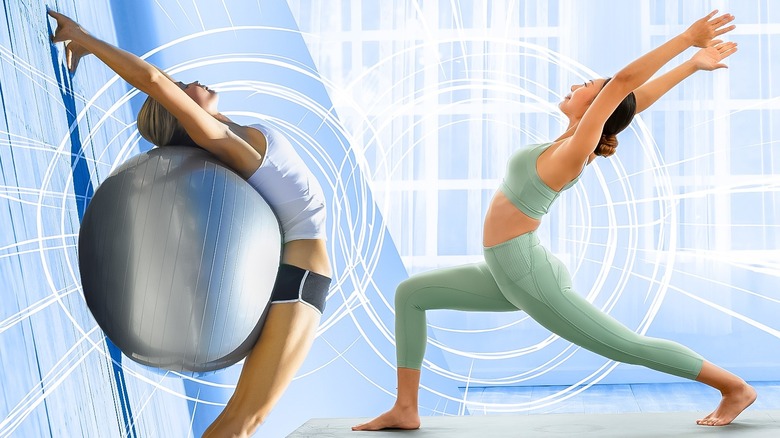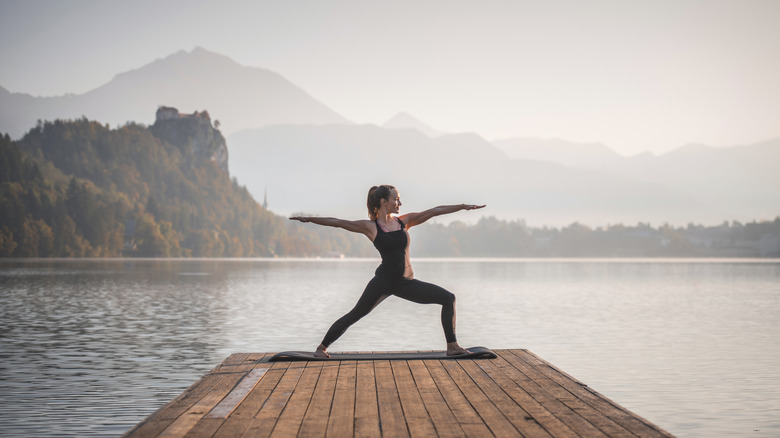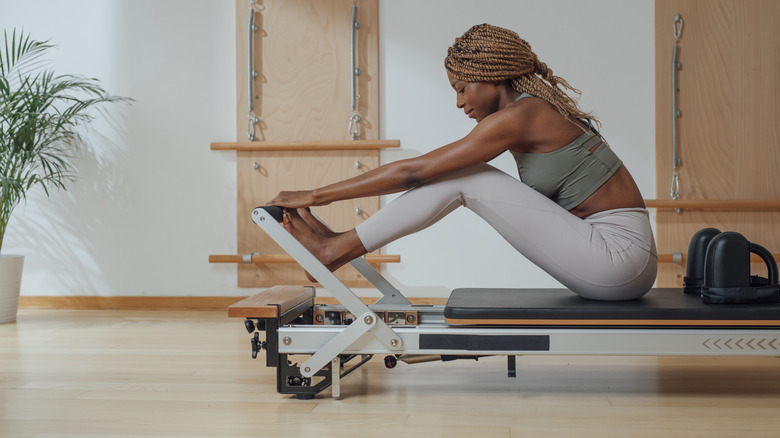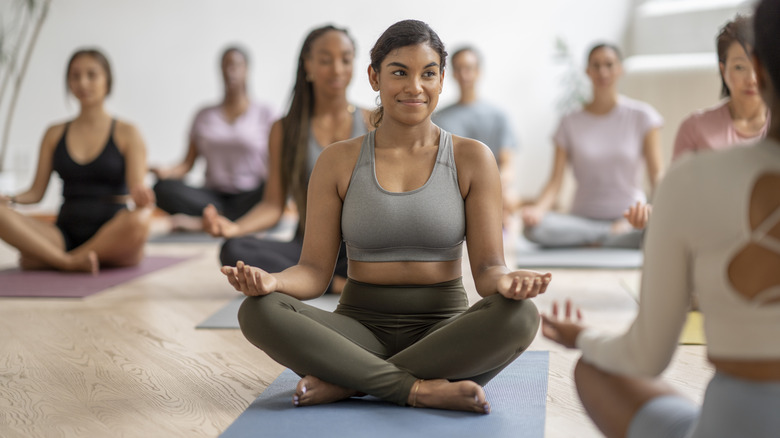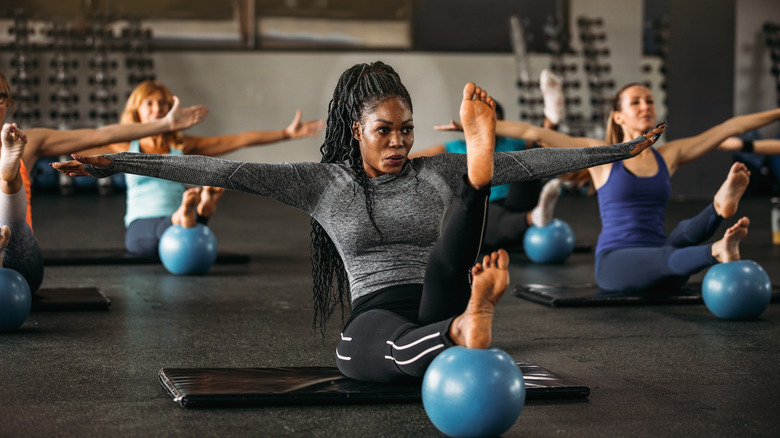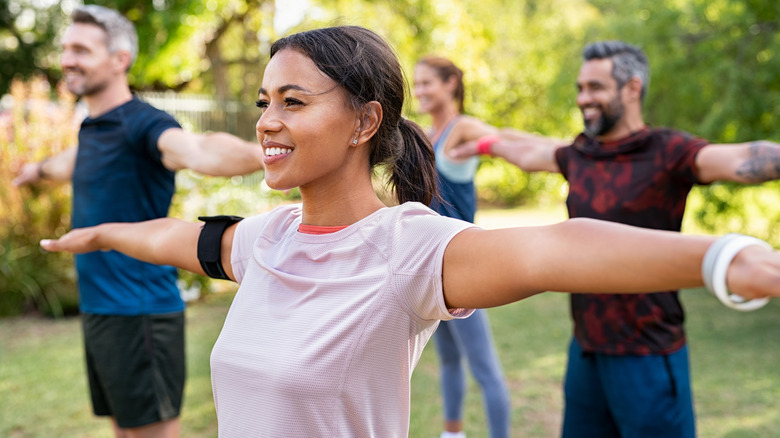What's The Difference Between Yoga And Pilates?
Are you tired of high-impact workouts that leave you with more sore muscles than you even knew you had? If so, it's time to look for a worthy alternative. Experts agree that yoga and Pilates are wonderful low-impact workouts based on bodyweight resistance that provide good, long-lasting results. You can even start your at-home yoga journey today. But are yoga and Pilates the same thing?
Far from its limited understanding as a fitness regimen, yoga is in reality a holistic wellness practice that dates back to ancient India. Zoe Bertali, a yoga teacher at The Refinery, told Harper's Bazaar, "Yoga is an integrated health management system using breath, movement and meditation to unite mind, body and spirit. It also incorporates elements of philosophy, science and an ethical way of living. Classes can range from gentle and nourishing to challenging and sweaty." Pilates on the other hand, is, "a physical system that uses very specific targeted exercises to improve strength, flexibility and posture with particular focus on the core. It is a disciplined practice that needs to be done on a regular basis to provide benefit," according to Bertali.
Though they offer similar holistic health benefits and, to a limited extent, work on similar principles such as a focus on breathing and body weight, yoga and Pilates are actually quite different from each other. If you are keen to learn the difference between them, it's important to understand what these two systems actually are.
Understanding the origins of yoga and Pilates
To truly understand the differences between yoga and Pilates, one must delve into their histories. Yoga is an ancient practice of overall wellbeing that targets physical, emotional, and spiritual health (per Medical News Today). As such, the physical movements practiced in yoga complement dietary and spiritual practices, such as following Ayurvedic principles and practicing meditation and mindfulness. According to Healthline, practicing yoga can help counteract anxiety and depression, fight symptoms of auto-immune disorders like multiple sclerosis, arthritis, high blood pressure, and certain respiratory conditions, and even help with type 2 diabetes.
On the other hand, Pilates is purely a physically restorative form of wellbeing. Developed by physical trainer Joseph Pilates in the early 1900s, it was aimed at correcting muscular imbalances and rehabilitating injured dancers and athletes through movements focused on developing strength, stability, and flexibility. Cleveland Clinic lists the benefits of Pilates as pain relief, greater core strength, better body awareness, mental health support, and improving posture, flexibility, and coordination.
Differences in the equipment used
When discussing the differences between yoga and Pilates, one must consider both the form and substance of the exercises. In terms of form, the equipment used in both practices differs significantly. Joseph Pilates invented various pieces of equipment to further his goal of strengthening the body. This equipment was designed to challenge physical strength and make people stronger. Examples of Pilates equipment include the original reformer, modern variations of the reformer, mats, and benches. Pilates also sometimes uses a ring, small exercise balls, ankle weights, light dumbbells, and mini bands.
As yoga is based on establishing a body-mind connection (per WebMD), it does not rely on any equipment. All one needs to do is to feel connected to their body by concentration on breathwork and holding the postures. A mat and comfortable clothing can be helpful, and some classes may incorporate tools like blankets, bolsters, and blocks to enhance the overall wellness experience.
Differences in their procedures
Yoga has evolved over thousands of years, and during that time, many people have adapted it to serve different purposes. Currently, around multiple forms of yoga are practiced, each with unique characteristics. Hatha yoga focuses on holding each pose for a few breaths, while ashtanga yoga follows a fixed sequence of poses to build internal heat, improve circulation, and create a strong body. Vinyasa yoga links breath with movements that mimic dance to increase heart rate.
Bikram and hot yoga are both practiced in hot rooms, with the former following a prescribed 90-minute sequence and the latter allowing for more flexibility. Iyengar yoga emphasizes precision in movement and proper body alignment to prevent and treat injuries, while Kundalini yoga aims to increase self-awareness. Yin yoga is a meditative practice that stretches connective tissue around the joints, and restorative yoga is designed to relax and restore.
Pilates also has different variations, including classical Pilates that combines mat and equipment exercises and contemporary Pilates that introduces modifications to the original form. Mat-based and reformer Pilates rely heavily on the equipment described in their names.
Are there any similarities between yoga and Pilates?
Although fundamentally different, yoga and Pilates both offer similar wellness benefits to their practitioners. Both practices are based on breathwork and help to develop core strength and balance. With their slow and deliberate movements, they also encourage flexibility in the body.
Practitioners of both yoga and Pilates note an improvement in their overall wellbeing, as these practices reduce stress and encourage better blood flow to the organs and joints. People who suffer from health or sports-related injuries are often recommended either yoga or Pilates as rehabilitative exercises. The gentle yet long-lasting effects on the human body also make them safe prenatal exercises for women who are expecting babies.
Patricia Sabulis, a Lululemon studio instructor, Yoga Alliance-certified yoga instructor, and NASM/ACE approved mat Pilates instructor told Glamour, "They're both practices that emphasize focus and being present in one's body and the connection between body and breath. Those are big ways that they're similar."
Is yoga or Pilates right for you?
After studying the differences and similarities between yoga and Pilates, it is time to determine which of these two wellness practices is right for you. According to WebMD, if you want to increase your strength and flexibility, Pilates is the way to go, while yoga is better suited to improving overall wellness and mindfulness due to its slower pace. Camai Brandenberg, a certified yoga and Pilates instructor, explained to Glamour "Yoga is a little bit more accessible for someone brand new."
"Neither yoga nor Pilates alone would be good choices for losing weight," James Bagley, PhD, an assistant professor of kinesiology at San Francisco State University, told Livestrong. So, if weight loss is your goal, you'll need to incorporate yoga, Pilates, or both into a broader plan that includes nutrition and other exercises. Ultimately, the best way to determine what works for you is to consult your doctor, take a class in each type of movement, and determine which one you prefer. You could also experiment with a Yogalates class, which is a practice combining yoga and Pilates started by personal trainer Jonathan Urla in 1997.
